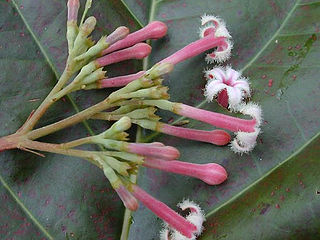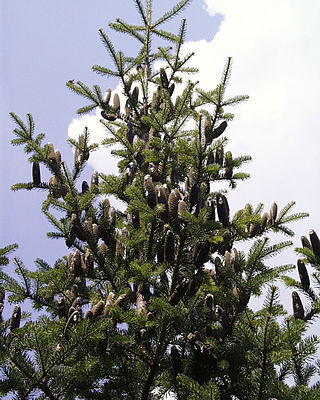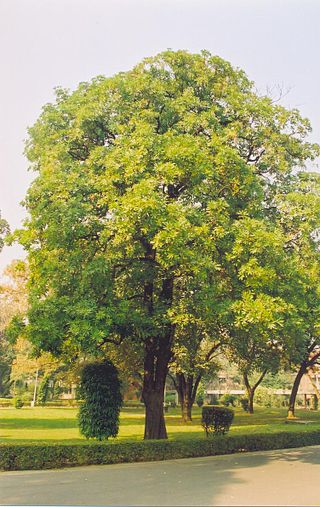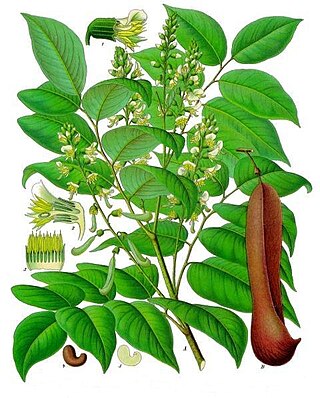
Willows, also called sallows and osiers, of the genus Salix, comprise around 350 species of typically deciduous trees and shrubs, found primarily on moist soils in cold and temperate regions.

Cinchona is a genus of flowering plants in the family Rubiaceae containing at least 23 species of trees and shrubs. All are native to the tropical Andean forests of western South America. A few species are reportedly naturalized in Central America, Jamaica, French Polynesia, Sulawesi, Saint Helena in the South Atlantic, and São Tomé and Príncipe off the coast of tropical Africa, and others have been cultivated in India and Java, where they have formed hybrids.

Alnus glutinosa, the common alder, black alder, European alder, European black alder, or just alder, is a species of tree in the family Betulaceae, native to most of Europe, southwest Asia and northern Africa. It thrives in wet locations where its association with the bacterium Frankia alni enables it to grow in poor quality soils. It is a medium-sized, short-lived tree growing to a height of up to 30 metres (98 feet). It has short-stalked rounded leaves and separate male and female flowers in the form of catkins. The small, rounded fruits are cone-like and the seeds are dispersed by wind and water.

Abies balsamea or balsam fir is a North American fir, native to most of eastern and central Canada and the northeastern United States.

Conocarpus erectus, commonly called buttonwood or button mangrove, is a hardy species of mangrove shrub in the family Combretaceae.

Jesuit's bark, also known as cinchona bark, Peruvian bark or China bark, is a former remedy for malaria, as the bark contains quinine used to treat the disease. The bark of several species of the genus Cinchona, family Rubiaceae indigenous to the western Andes of South America, was introduced to Jesuit missionaries as a traditional treatment for malaria by indigenous people in Peru during the 17th century.

Styrax is a genus of about 130 species of large shrubs or small trees in the family Styracaceae, mostly native to warm temperate to tropical regions of the Northern Hemisphere, with the majority in eastern and southeastern Asia, but also crossing the equator in South America. The resin obtained from the tree is called benzoin or storax, often used as a vanilla-like component in perfumery.

Schinus terebinthifolia is a species of flowering plant in the cashew family, Anacardiaceae, that is native to subtropical and tropical South America. Common names include Brazilian peppertree, aroeira, rose pepper, broadleaved pepper tree, wilelaiki, Christmasberry tree and Florida holly. The species name has been very commonly misspelled as ‘terebinthifolius’.

Tolu balsam or balsam of Tolu is a balsam that originates from South America. It is similar to the balsam of Peru.

Prosopis pallida is a species of mesquite tree. It has the common names kiawe, huarango and American carob, as well as "bayahonda", "algarrobo pálido", and "algarrobo blanco". It is a thorny legume, native to Colombia, Ecuador and Peru, particularly drier areas near the coast. While threatened in its native habitat, it is considered an invasive species in many other places.

Cinchona officinalis is a South American tree in the family Rubiaceae. It is native to wet montane forests in Colombia, Ecuador, Peru and Bolivia, between 1600–2700 meters above sea level.
Alchornea castaneifolia is a medicinal plant native to Amazon Rainforest vegetation in Brazil.

Alstonia scholaris, commonly called blackboard tree, scholar tree, milkwood or devil's tree in English, is an evergreen tropical tree in the dogbane family (Apocynaceae). It is native to southern China, tropical Asia and Australasia, where it is a common ornamental plant. It is a toxic plant, but is used traditionally for myriad diseases and complaints. It is called 'Saptaparna' in India and is the sacred tree of the 2nd Jain tirthankar Ajitnatha.

Podocarpus milanjianus is a species of conifer in the family Podocarpaceae. It is native to the highlands and mountains of tropical Africa.

Heliotropium arboreum is a species of flowering plant in the borage family, Boraginaceae. It is native to tropical Asia including southern China, Madagascar, northern Australia, and most of the atolls and high islands of Micronesia and Polynesia. Common names include velvetleaf soldierbush, tree heliotrope, veloutier, and octopus bush. It is a shrub or small tree typical of littoral zones reaching a height of 3.6 m (12 ft), with a spread of about 5 m (16 ft).

Khaya anthotheca, with the common name East African mahogany, is a large tree species in the Meliaceae family, native to tropical Africa.

Croton eluteria, known as cascarilla, is a plant species of the genus Croton that is native to the Caribbean. It has been naturalized in other tropical regions of the Americas. It grows to be a small tree or tall shrub, rarely reaching 20 feet (6 m) in height. Its leaves are scanty, alternate, ovate-lanceolate, averaging 2 inches (5 cm) long, with close scaling below, giving a metallic silver-bronze appearance, and scattered white scales above. The flowers are small, with white petals, and very fragrant, appearing in March and April. The scented bark is fissured, pale yellowish brown, and may be covered in lichen.

Gliricidia is a genus of flowering plants in the legume family, Fabaceae and tribe Robinieae. Its native range is Mexico to Peru, but Gliricidia sepium has been widely introduced to other tropical zones.
Lissocarpa is a genus of flowering plants, described as a genus in 1876. It is classified as belonging to the family Ebenaceae, the ebony and diospyros family. It includes only a few species of small evergreen trees and shrubs species native to tropical South America.

Myroxylon balsamum, Santos mahogany, is a species of tree in the family Fabaceae. It is native to tropical forests from Southern Mexico through the Amazon regions of Peru and Brazil at elevations of 200–690 metres (660–2,260 ft). Plants are found growing in well drained soil in evergreen humid forest.



















